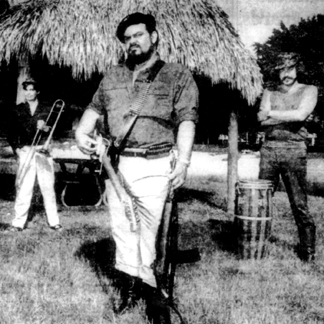Global Beat: Alfonso Lovo

On Dec. 12, 1971, Alfonso Lovo, the 20-year-old son of Nicaragua’s Minister of Agriculture, was flying home from Miami when three Sandinista rebels, their weapons drawn, forced the plane to land in Costa Rica. They intended to refuel and take off for Cuba – a plan that the Costa Rican government didn’t want any part of, prompting one of the hijackers to vent his anger by emptying a pistol into Lovo. Miraculously, the young student recovered from his wounds in a local hospital; his captors weren’t so lucky.
A year later, almost to the day, Nicaragua’s capital city of Managua was leveled by a devastating earthquake. Lovo was at school in Atlanta but he was profoundly effected by the event. He used his political and business connections to organize a benefit concert at Managua’s national stadium, with Santana as the headlining act. The band’s charismatic percussionist, José “Chepito” Areas, was a childhood friend of Lovo’s. The two had played music together in a high school halftime band – Chepito on drums, Lovo on guitar – and that night, in October 1973, they talked about collaborating again if the timing was right.
“Chepito taught everybody how to play that Latin rock thing,” Lovo recalls. “That’s his claim to fame, really. By that time, I was going to business school at [Louisiana State University in Baton Rouge], but I lived for a long time in New Orleans. I used to go to Bourbon Street just about every night, so I had a lot of friends in jazz groups and I used to jam with a lot of them.”
With backing musicians recruited from New Orleans, he recorded his first album, Terremoto Richter 6:25, in 1974. Meant as a cathartic response to the earthquake’s grinding aftermath, the music combined elements of Latin percussion, Caribbean funk and psychedelic soul, with Lovo’s guitar styles ranging from flamenco to straight-up jazz styles. It was an uneven but auspicious effort that established Lovo as a raw talent – he couldn’t sight-read or score music, but he could write entire horn arrangements by ear. He was also a restless seeker of new electronic sounds.
In early 1976, Lovo booked the best studio in Managua and convinced Chepito to take a brief hiatus from Santana. He assembled the hottest players that he could find, including recording engineer and bassist Roman Cerpas, a veteran of the Nicaraguan space-rock band Bwana. And during the next three months, Lovo proceeded to make a Latin jazz-fusion masterpiece that rivaled the sonic scope of Santana’s Caravanserai, Herbie Hancock’s Sextant or even Lee Scratch Perry’s Blackboard Jungle Dub.
“I was playing guitar and Fender Rhodes, and we had all these flangers and effects,” Lovo explains. Among the arsenal were a Moog synthesizer and an Echoplex tape delay, which lent the controversial 8-minute jam “La Bomba De Neutron” its otherworldly, apocalyptic air. “We had all this new equipment that was coming out, and we were experimenting with all these sounds. In Nicaragua, that was far out in those days. And the musicians were really outta sight. Having Chepito there made a big difference.”
He called it La Gigantona (loosely translated, “The Giant Lady” ), after the nine-foot effigy of old Spanish matriarchal rule that apeared annually in street festivals around the city. Just as Lovo was preparing to release the album, which had been mastered in Los Angeles and cut to vinyl acetate, the first vestiges of civil war started breaking Nicaragua into fractured pieces.
“It was unreal,” Lovo says. “We got out in a rush. I packed up my piano, my guitars and, with my wife and my daughter, we drove over the border to Honduras in the middle of a war. I didn’t even realize if I’d brought the record with me or not. I definitely didn’t bring the master tapes, so I just figured it was lost.”
Many years later in Miami, Lovo’s daughter was sifting through some old boxes that the family had kept in storage. Among her father’s keepsakes, she found a stack of records that included a pristine vinyl copy of La Gigantona. Lovo sent reference CDs around to people who he knew in the music industry, and eventually, Numero Group got hold of it. Now, more than 35 years after it was made, La Gigantona is finally getting a proper release.
“Music has never been my real profession, but it’s been my passion, you know?” Lovo says. “You have to take your chances and make something that you feel is new. Maybe people won’t like it, but if you at least put your heart into it, you can get a larger reward out of that. Sometimes you plan something so well, and you work really hard and you try to push it, and it never ripens. It happened to me. And then something I had in a closet – in a box – that I forgot about, my daughter finds it and suddenly it’s all over the place. It’s amazing. It’s something that I never expected.”



















